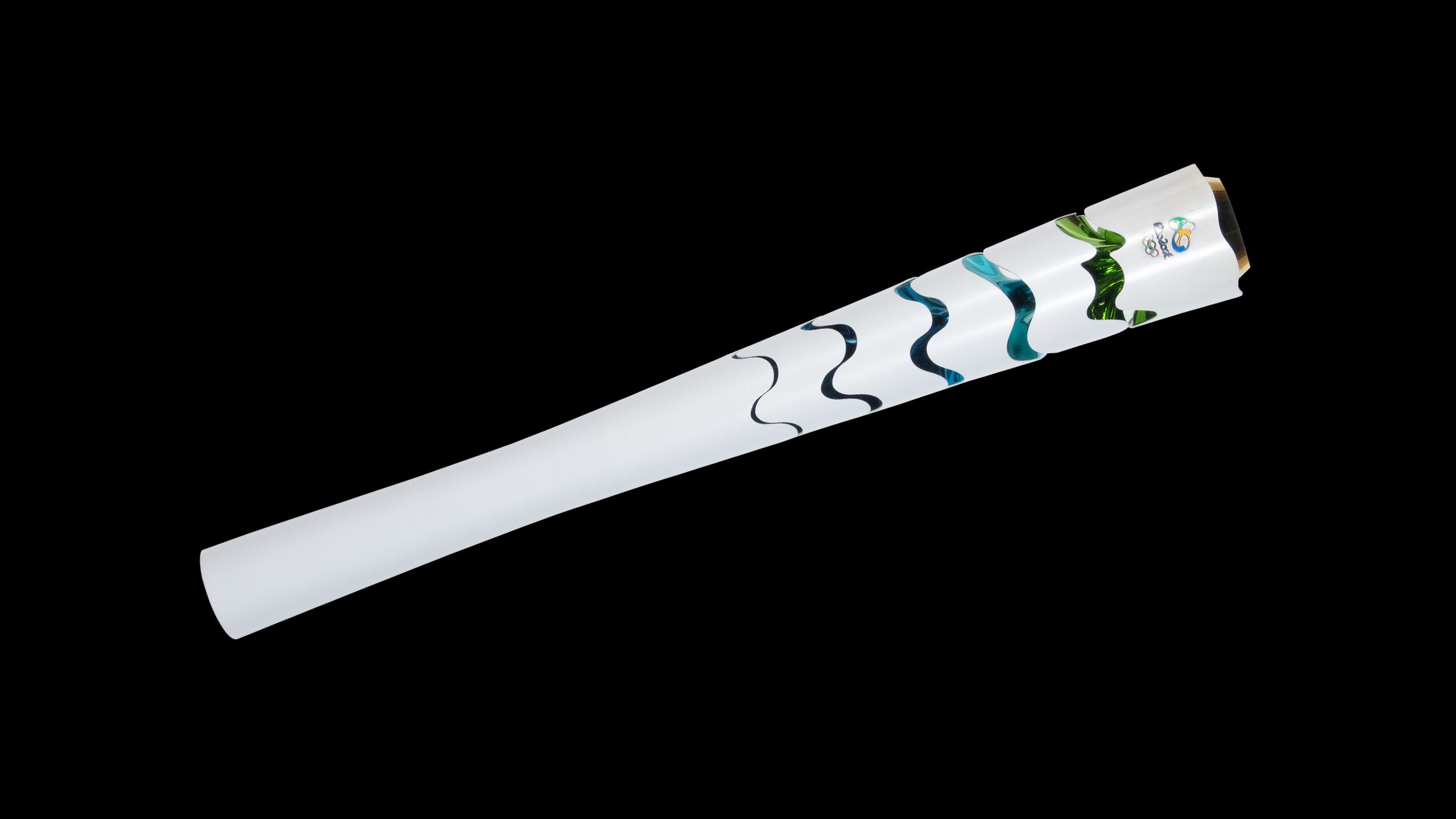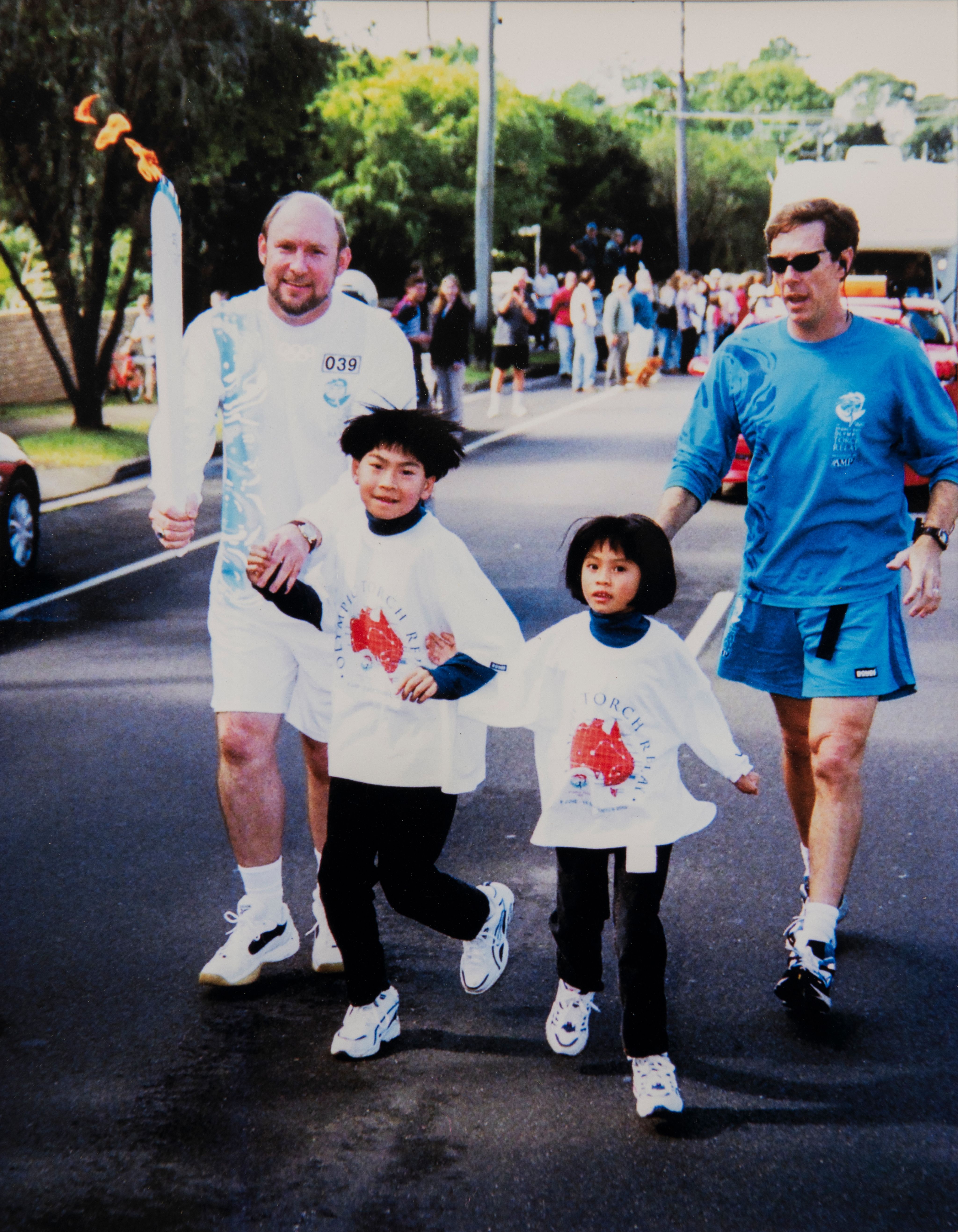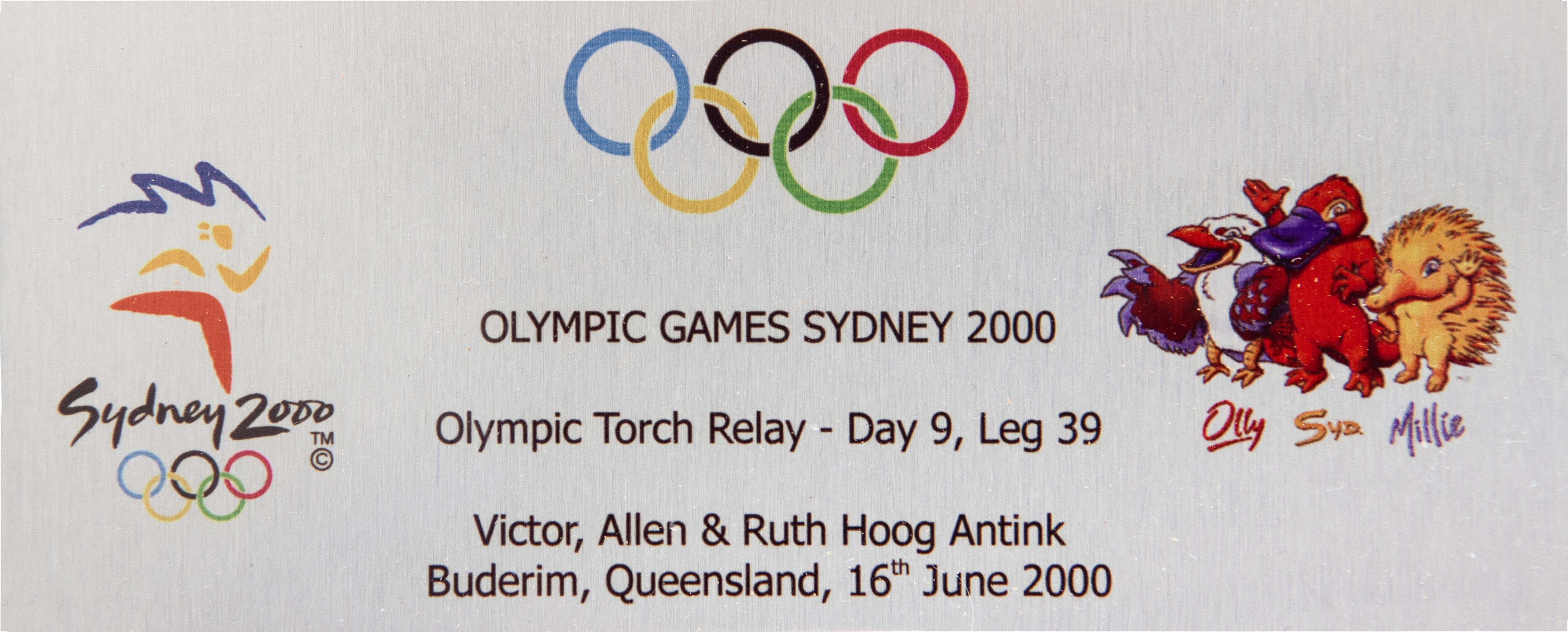
The spirit of the Olympic Games burns bright in Victor Hoog Antink who spent decades amassing his collection of 21 Olympic torches, now on display at Bond University.
Bond University Vice Chancellor and President Professor Tim Brailsford and Victor Hoog Antink AM.
Bond University Vice Chancellor and President Professor Tim Brailsford and Victor Hoog Antink AM.
Victor Hoog Antink’s first touch of an Olympic torch felt like a gift from the Greek god Zeus himself. In 2000, ahead of the Sydney Games, Mr Hoog Antink AM was a runner in the Olympic Torch Relay as it passed through Buderim on the Sunshine Coast.
“That run was amazing,” he recalled. “The crowds were immense and the route was lined with cheering people. I received an unexpected adrenaline rush which made me run with even more purpose. It felt like that saying in Chariots of Fire - ‘with wings on our heels’.”
Thus began a collection of 21 Summer Olympics torches, the earliest from the 1936 Berlin Games, housed in the The Hoog Antink Olympic Room atBond University.




Berlin 1936
- The torch used in the first modern Olympic Torch Relay. Design features the relay route and Olympic rings topped by a German eagle.
- Composition: Steel
- Length: 28cm
- Relay distance: 3,365km
- Torchbearers: 3,075
- Final torchbearer: Fritz Schilgen (track and field)
London 1948
- Bears the inscription ‘Olympia to London with thanks to the bearer XIVth Olympiad 1948’. To ensure the flame burned brighter in the stadium, a magnesium flare was used.
- Composition: Steel, aluminium
- Length: 40.5cm
- Relay distance: 3,365km
- Torchbearers: 1,416
- Final torchbearer: John Mark (track and field)
Helsinki 1952
- The rarest Olympic torch with only 22 produced. The handle is made of lacquered birch wood. This one is a replica.
- Composition: Silver, metal, wood
- Length: 59cm
- Relay distance: 7,420km
- Torchbearers: 3,042
- Final torchbearers: Paavo Nurmi and Hannes Kolehmainen (track and field)
Melbourne 1956
- Modelled on the London 1948 design. A torch of slightly different design was used for the final run to the cauldron, during which it burned Ron Clarke.
- Composition: Silver, metal, wood
- Length: 59cm
- Relay distance: About 20,470km
- Torchbearers: 3,181
- Final torchbearer: Ron Clarke (track and field)
Origin of the Olympic flame
The Ancient Olympic Games took place every four years at Olympia in modern-day Greece from 776BC until at least 393AD. Sacred fires were common at Greek temples, and at the Games a large basin of fire burned for the entirety of the ceremonies and competitions.




Rome 1960
- Designed by archaeologist Amedeo Maiuri, the look was inspired by ancient monuments common to Rome and Greece.
- Composition: Aluminium
- Length: 39.5cm
- Relay distance: 1,863km
- Torchbearers: 1,529
- Final torchbearer: Giancarlo Peris (track and field)
Tokyo 1964
- The torch bears the inscription ‘XVIII Olympiad Tokyo 1964’ and the Olympic rings. Fuelled by gunpowder.
- Composition: Aluminium, steel
- Length: 72cm
- Relay distance: 26,065km
- Torchbearers: About 100,605
- Final torchbearer: Yoshinori Sakai (track and field)
Mexico City 1968
- As many as six different versions of the torch were used due to problems caused by poor design.
- Composition: Steel, leather, wood, metal
- Length: 45-53cm
- Relay distance: 13,536km
- Torchbearers: 2,778
- Final torchbearer: Enriqueta Basilio (track and field)
Munich 1972
- Designed by Friedrich Krupp AG, the same company that produced the torch for the 1936 Berlin Games.
- Composition: Steel, other metal
- Length: 72cm
- Relay distance: 5,532km
- Torchbearers: About 6,200
- Final torchbearer: Günther Zahn (track and field)
Modern torch relay
Prior to the 1932 Berlin Olympics, an Olympic flame was lit at only two modern Games: Amsterdam 1928 and Los Angeles 1932. In both cases there was no Olympic Torch Relay. For the Berlin Games it was decided to light the fire in Olympia using parabolic mirror reflecting the sun’s rays and have runners bring it to the Olympic Stadium. To do so they needed a torch, and an Olympic tradition was born.




Montreal 1976
- For the first time, two people lit the Olympic cauldron. They were chosen to symbolise Canada’s Anglophone and Francophone communities.
- Composition: Aluminium
- Length: 67.5cm
- Relay distance: 775km.
- Torchbearers: 761
- Final torchbearers: Sandra Henderson (gymnastics), Stéphane Préfontaine (track and field)
Moscow 1980
- Concentric circles around the burner with a protective screen midway down the shaft.
- Composition: Aluminium
- Length: 56.5cm
- Relay distance: 5,000km
- Torchbearers: About 5,435
- Final torchbearer: Sergei Belov (basketball)
Los Angeles 1984
- The final torchbearer Rafer Johnson had to climb 96 steps to the cauldron and suffered a serious leg cramp during training. A back-up torchbearer, Caitlyn Jenner (then known as Bruce), was appointed.
- Composition: Aluminium, bronze, leather
- Length: 58.5cm
- Relay distance: 15,000km in the US
- Torchbearers: 3,636
- Final torchbearer: Rafer Johnson (track and field)
Seoul 1988
- The design features two engraved dragons symbolising the harmony of East and West. In Chinese astrology, the dragon was also the sign for the year 1988
- Composition: Metal, copper, leather, plastic
- Length: 51cm
- Relay distance: 4,168km in South Korea
- Torchbearers: 1,467 in South Korea
- Final torchbearer: Chung Sun-man (non-athlete) and Kim Won-tak (track and field)
The Hoog Antink collection
Mr Hoog Antink’s Sydney Games torch run lit a fire within him.
“I was at Westfield at the time and they were a sponsor,” he said. “When you ran with the torch you were given an option to buy it, which I did. Then one day I was just scrolling through eBay and I saw another torch, so I bought a second one. And then I thought, ‘OK, so how many are there?’ And from there I started progressively collecting.”




Barcelona 1992
- An asymmetrical torch with the axis pointing symbolically in the direction of Barcelona.
- Composition: Aluminium, plastic
- Length: 66cm
- Relay distance: 367km in Greece, 5,940km in Spain
- Torchbearers: 365 in Greece, 9,484 in Spain
- Final torchbearer: Antonio Rebollo (archery)
Atlanta 1996
- Engraved on the wooden handle is the list of Summer Games from 1896 to 1996, in reference to the centenary of the Olympics.
- Composition: Aluminium, brass, pecan wood
- Length: 82cm
- Relay distance: 2,141km in Greece and 12,467km in the US
- Torchbearers: ~800 in Greece and 12,467 in the US
- Final torchbearer: Muhammad Ali (boxing)
Sydney 2000
- Inspired by the Sydney Opera House, the blue of the Pacific Ocean and the boomerang. It later inspired the design of Q1 on the Gold Coast.
- Composition: Steel, aluminium
- Length: 77.5cm
- Relay distance: 27,000km in Australia
- Torchbearers: 11,000 in Australia
- Final torchbearer: Cathy Freeman (track and field)
Athens 2004
- The shape of the torch recalls the lines of an olive tree leaf.
- Composition: Olive wood, aluminium
- Length: 65.5cm
- Relay distance: 78,000km by land, air and sea
- Torchbearers: 7,700 in Greece
- Final torchbearer: Nikolaos Kaklamanakis (sailing)
The Bond connection
Rather than making his name in sport, Mr Hoog Antink distinguished himself in the business world. Melbourne-born and Brisbane-raised, he completed a Bachelor of Commerce at the University of Queensland, then graduated from the Australian Army Officer Cadet Training School. He undertook an MBA at Harvard University where he met Dr Helen Nugent AC who would become Bond’s seventh Chancellor. Mr Hoog Antink went on to become the Director of Funds Management at Westfield for eight years where he worked with the Australian business titan Sir Frank Lowy. He was also CEO of DEXUS Property Group.
When Mr Hoog Antink and Dr Nugent crossed paths years after their time at Harvard, she urged him to get involved with Bond University and before long he was serving on the Bond University Council and its Business School Advisory Board.




Beijing 2008
- The shape of the torch recalls a parchment scroll. A pattern representing lucky clouds covers the surface of the upper part of the torch.
- Composition: Aluminium, rubber
- Length: 72cm, derived from 8 x 9, numbers that represent luck and longevity in Chinese culture
- Relay distance: 137,000km
- Torchbearers: 21,800
- Final torchbearer: Li Ning (artistic gymnastics)
London 2012
- The torch is perforated by 8,000 circles in reference to the 8,000 torchbearers and the 8,000 miles of the relay in the United Kingdom.
- Composition: Metal, aluminium
- Length: 80cm
- Relay distance: 15,775km
- Torchbearers: 8,000 in the UK
- Final torchbearer: Seven young athletes chosen by UK Olympic champions
Rio de Janeiro 2016
- Torch expands vertically when the Olympic flame is passed from one torchbearer to another. Colours reflect the Brazilian flag.
- Composition: Recycled aluminium, resin
- Length: 69cm
- Relay distance: 26,000km in Brazil
- Torchbearers: 12,500 in Brazil
- Final torchbearer: Vanderlei Cordeiro de Lima, (track and field)
Tokyo 2020
- Takes its inspiration from the sakura cherry-blossom. Flame had special reddish colour.
- Composition: Aluminium
- Length: 71cm
- Relay distance: About 2,000km
- Torchbearers: 10,515
- Final torchbearer: Naomi Osaka (tennis)
The hunt for a Paris 2024 torch
Mr Hoog Antink began the search for a Paris 2024 torch shortly after the Games ended. It turned out to be the second most difficult acquisition in his collection.
“There were only 1500 torches compared to over 10,000 runners. Many of the torches were given to the cities through which the torch relay ran, to the Olympic organisations around the world, and to celebrities,” he said. "So that means virtually no one wants to give them up.”
He eventually sourced one from Portugal.
The most difficult torch to acquire was the rarest in Olympics history, Helsinki 1952. Just 22 were produced and only 17 are thought to remain. One sold at auction in London for a record £420,000 in 2015. Mr Hoog Antink’s Helsinki torch is a high-quality replica that he had to travel across the globe to retrieve.
“I tracked one down in Greece and ended up flying there to collect it because the seller didn't want to pay for the insurance or the freight!”

Paris 2024
- Design meant to represent equality, water (the Opening Ceremony took place on the Seine), peace and serenity.
- Composition: Recycled stainless steel
- Length: 70cm, 10cm at centre, tapered to 3.5cm at both ends
- Relay distance: 17,000km
- Torchbearers: 11,000
- Final torchbearers: Marie‑José Pérec (track and field) and Teddy Riner (judo)
Paying it forward
Mr Hoog Antink said sharing his collection with Bond University was a true pleasure.
“I have been truly blessed, as I think we all are to live in Australia, and I think I have been even more blessed by the experiences that I have had and the opportunities that I have been given,” he said. “I think it is only fair to share those experiences and financial benefits with a wider range of people given that I have been supported to get to where I am. I think it's only fair to pay it forward.”
Sources: The Olympic Studies Centre, Encyclopedia Britannica
Published on 7 August, 2024.
Original thinking direct to your inbox

Stories from Bond



